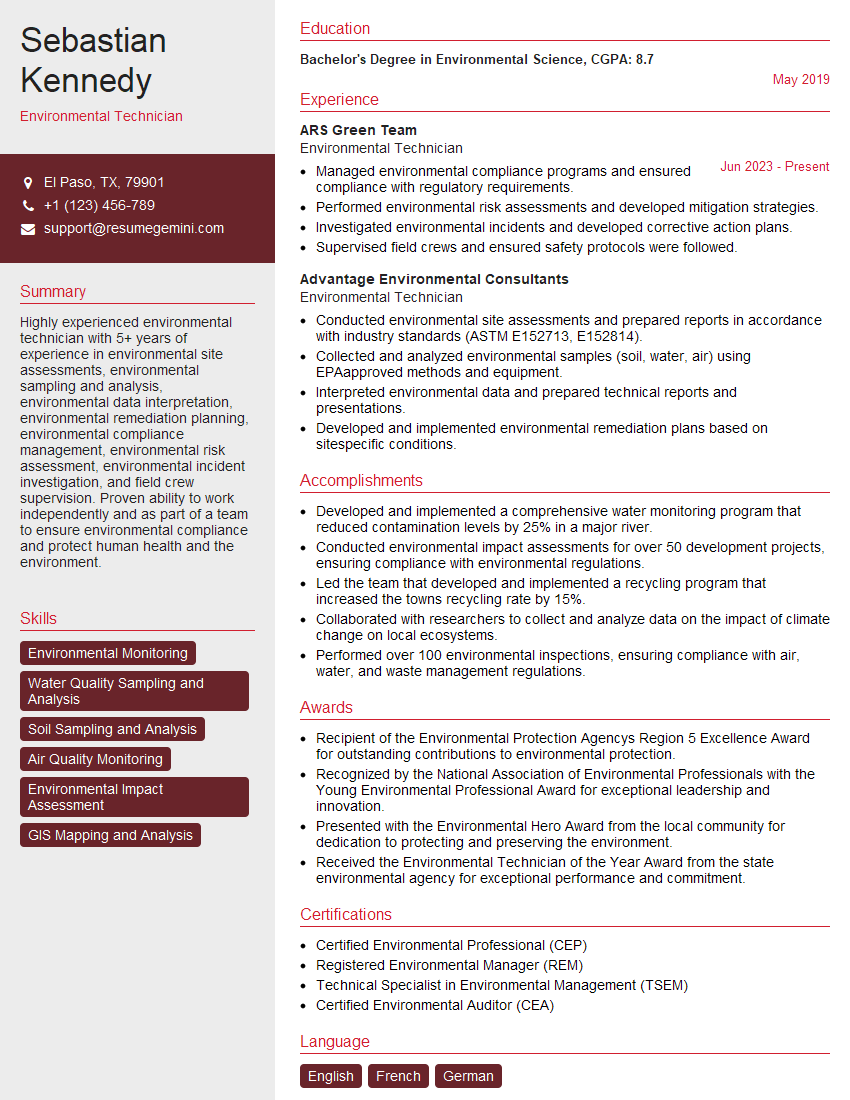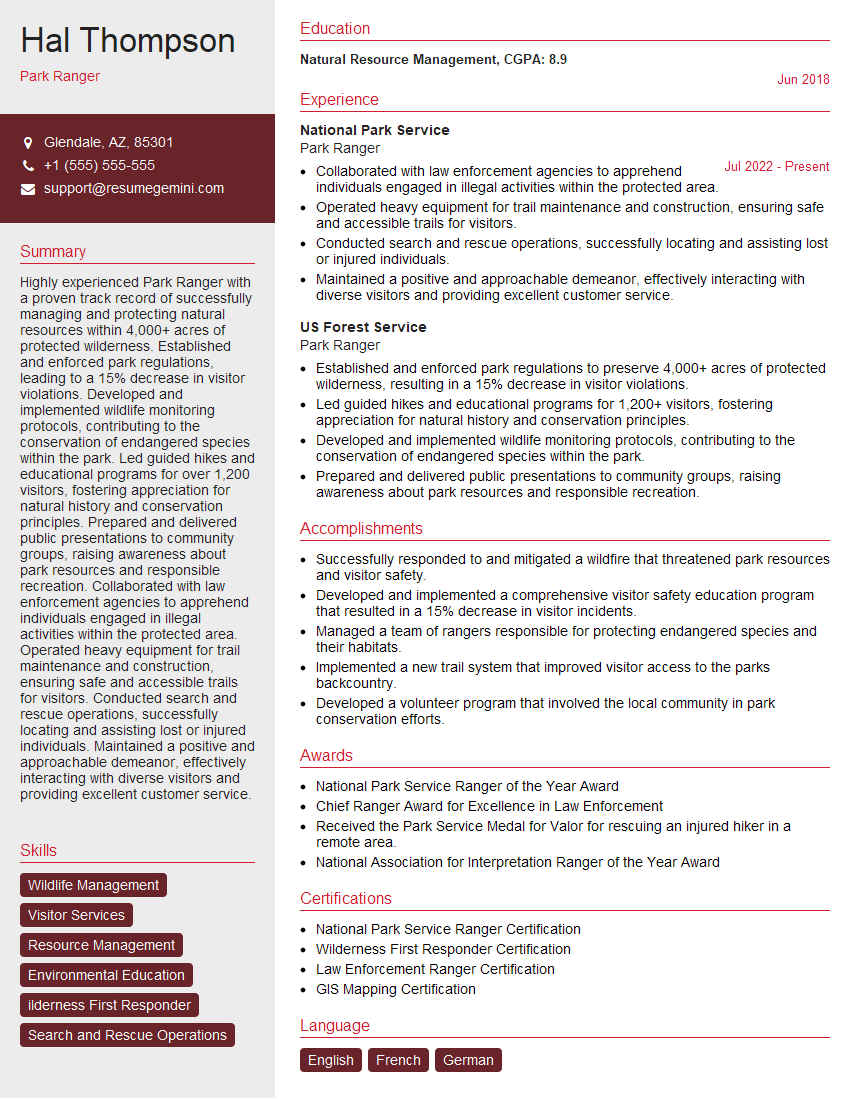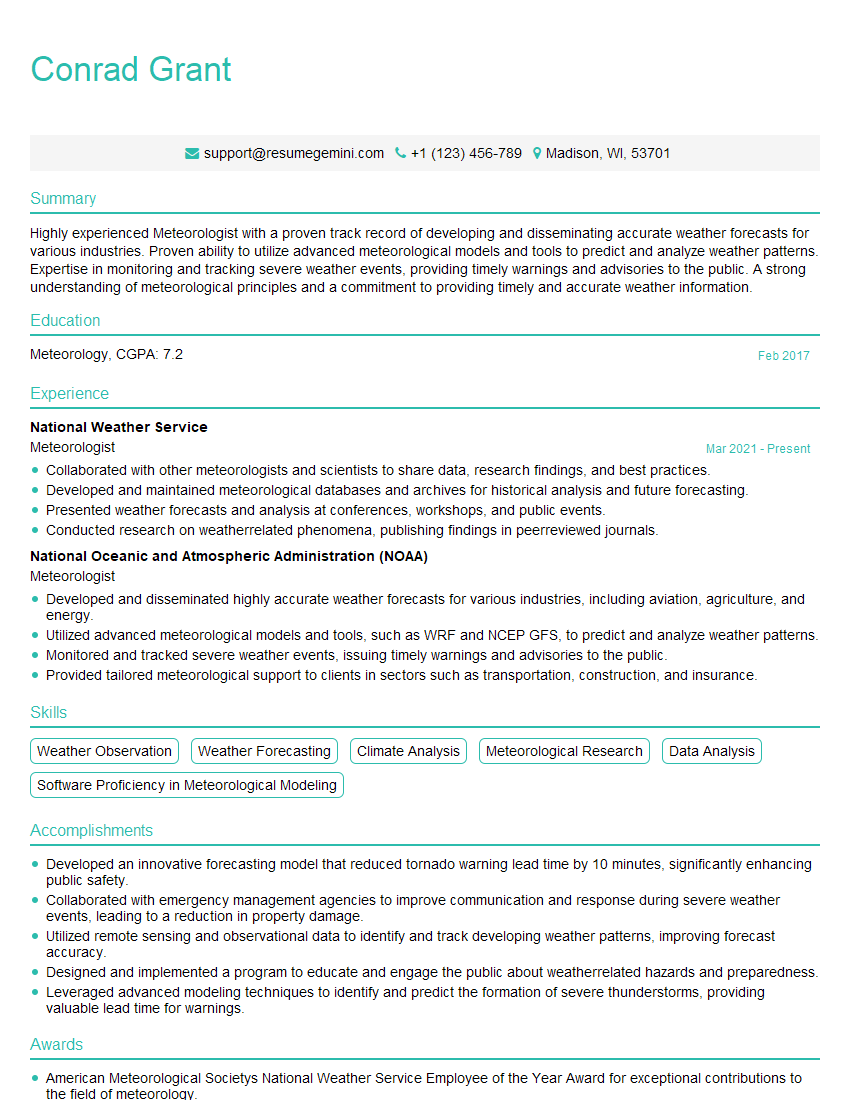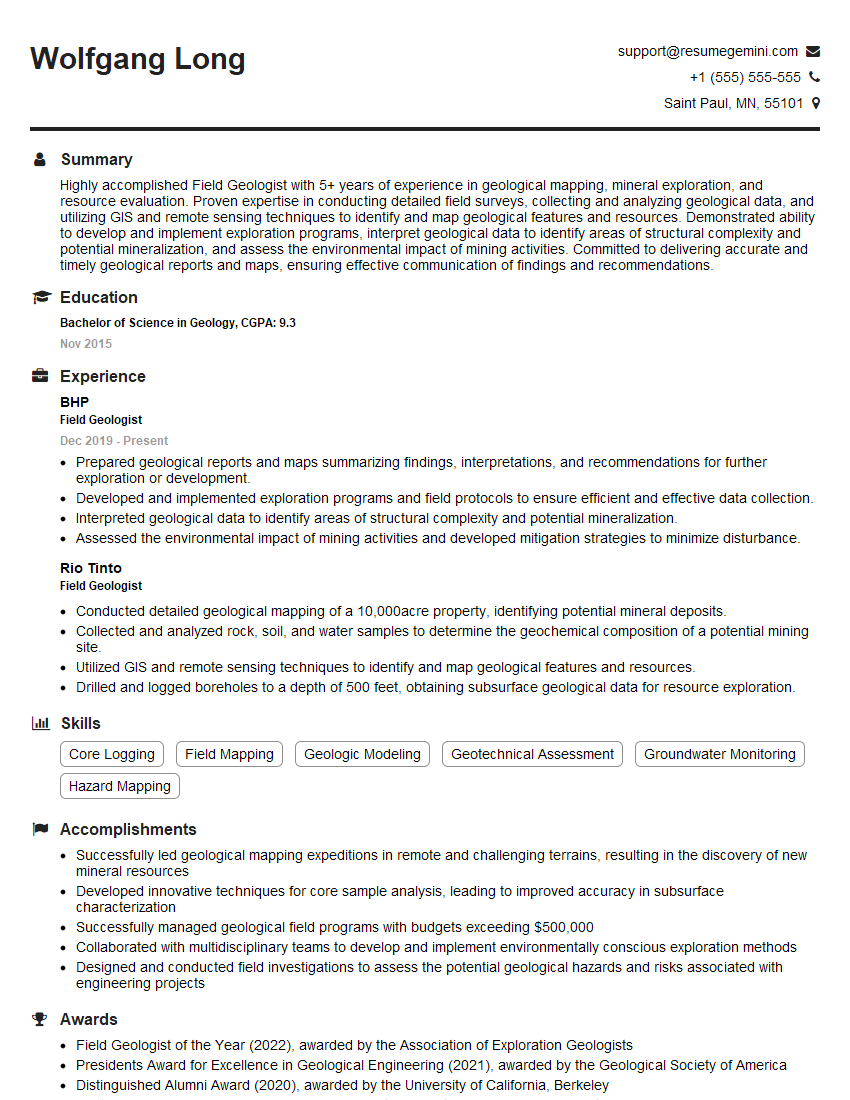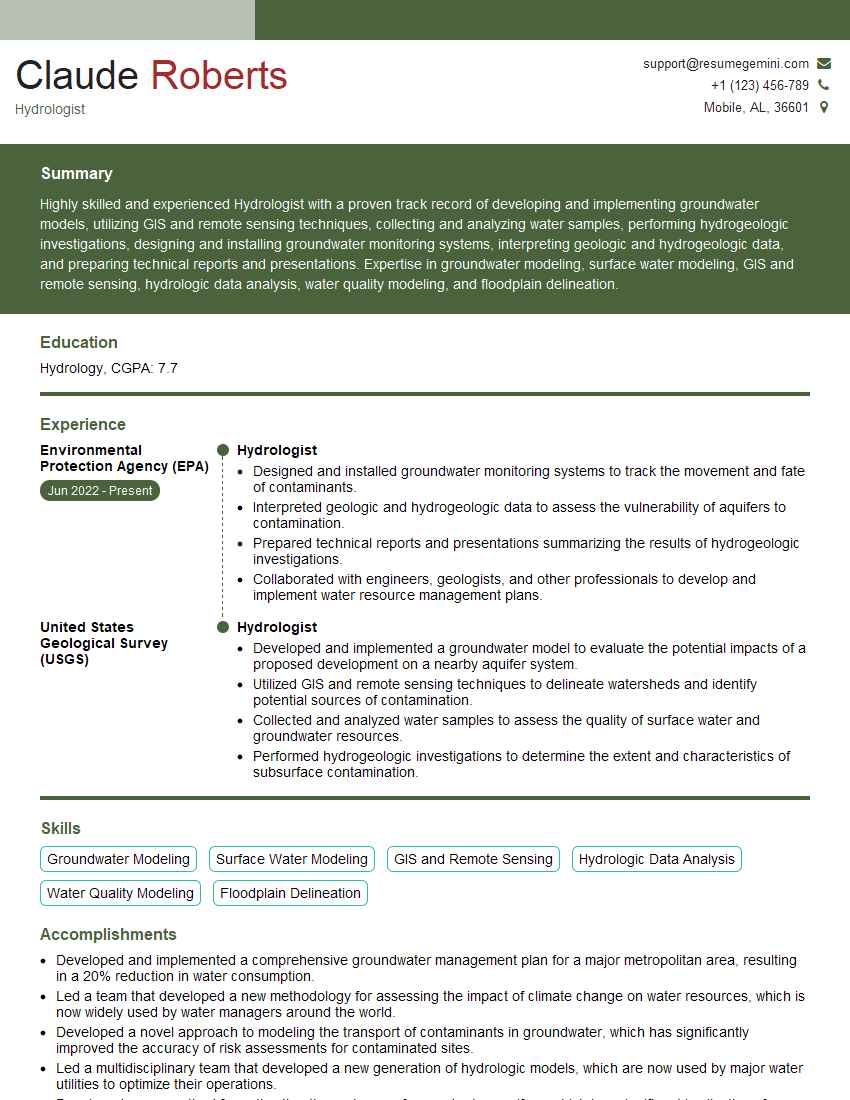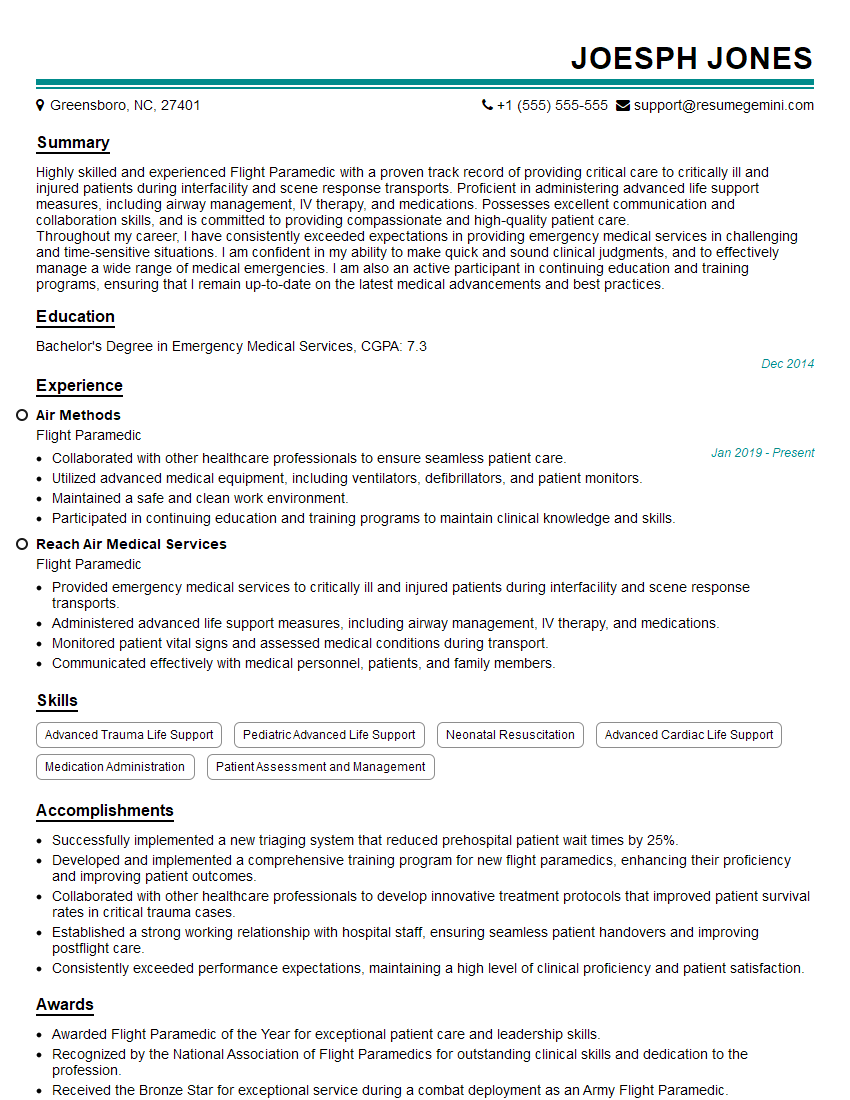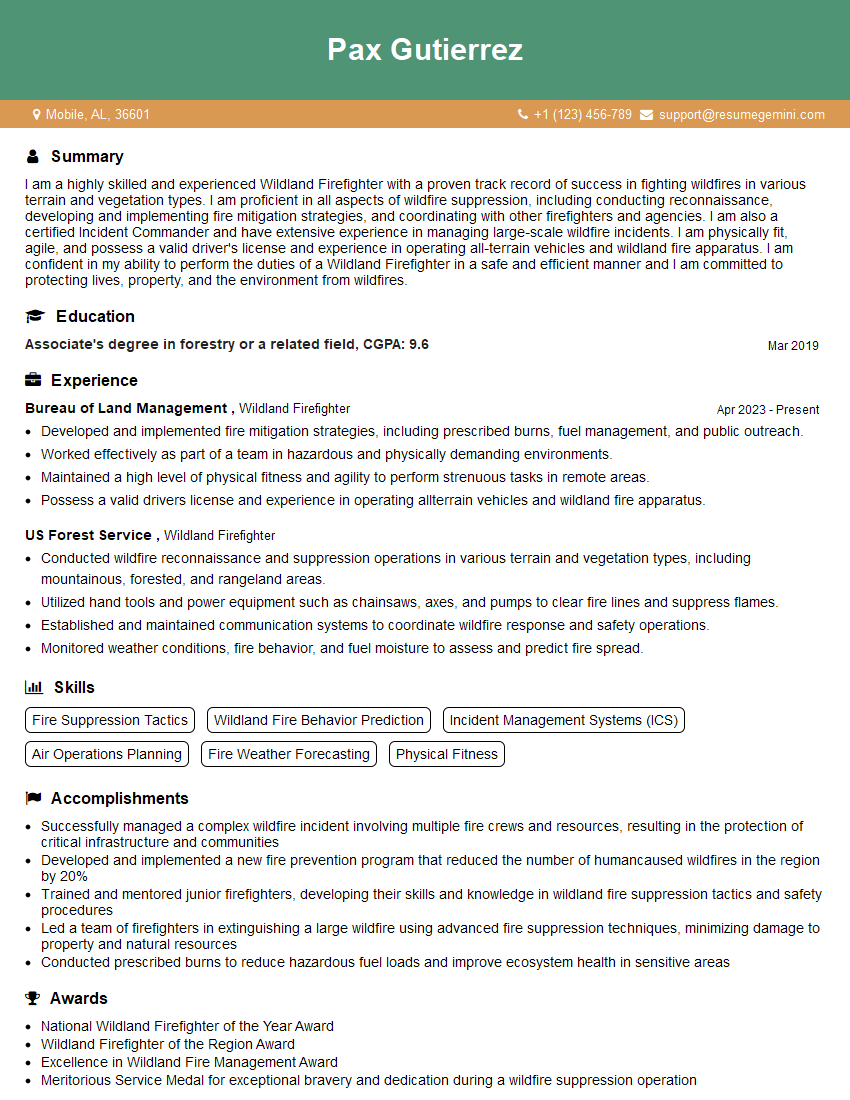Every successful interview starts with knowing what to expect. In this blog, we’ll take you through the top Work in extreme weather conditions interview questions, breaking them down with expert tips to help you deliver impactful answers. Step into your next interview fully prepared and ready to succeed.
Questions Asked in Work in extreme weather conditions Interview
Q 1. Describe your experience working in extreme weather conditions.
My experience working in extreme weather spans over fifteen years, primarily in the field of geological surveying and environmental research. This has exposed me to a wide range of challenging conditions, from blistering desert heat exceeding 50°C to sub-zero temperatures in arctic regions, reaching -30°C. I’ve also worked through intense storms, heavy snowfalls, and periods of prolonged rainfall resulting in flooding.
These experiences weren’t just about enduring discomfort; they involved adapting work strategies, implementing rigorous safety protocols, and making crucial decisions under pressure. For example, during a particularly severe blizzard in the Canadian Rockies, we had to make a rapid decision to evacuate our base camp after assessing the escalating risk of avalanches. This involved carefully securing equipment, navigating treacherous terrain in near-whiteout conditions, and prioritizing everyone’s safety.
Q 2. What safety protocols do you follow in extreme weather?
Safety protocols in extreme weather are paramount. They are not optional add-ons but are fundamental to job execution. My approach is layered and incorporates various elements:
- Pre-work Planning: Thorough weather forecasting is essential. We use multiple sources, including meteorological reports, and satellite imagery to anticipate and adjust for changes.
- Appropriate Gear: Choosing the right clothing and equipment is critical. This involves layering for cold conditions, wearing high-visibility clothing in low-visibility conditions, and using specialized gear for protection against sun, rain, snow, or extreme temperatures. This also includes employing proper personal protective equipment (PPE) specific to the tasks at hand.
- Communication: Maintaining clear and consistent communication among team members is vital. We use two-way radios and satellite phones to report conditions, location, and any emergencies. Regular check-ins are scheduled, especially in isolated work areas.
- Emergency Procedures: We establish clear emergency protocols, including evacuation plans, first aid procedures for weather-related injuries (hypothermia, heatstroke, frostbite), and communication procedures in the case of loss of contact.
- Regular Health Checks: Frequent health checks and hydration breaks are implemented to monitor for signs of heatstroke or hypothermia, ensuring everyone is alert and functioning safely.
Q 3. How do you adapt your work strategies to different weather conditions?
Adapting work strategies to different weather conditions requires flexibility and a thorough understanding of the environmental challenges.
- Heat: In extreme heat, we alter our work schedule to avoid the hottest part of the day, utilize shaded areas when possible, and increase the frequency of breaks for hydration and rest. We also use specialized heat-resistant clothing and equipment.
- Cold: In cold conditions, we shorten work durations to minimize exposure, utilize heated shelters or vehicles when available, and incorporate frequent warm-up periods. We prioritize tasks that require less physical exertion in severe cold.
- Wind/Rain: During windy or rainy conditions, we may adjust our work location or postpone tasks involving heights or exposed equipment. Shelter is prioritized to prevent injuries and equipment damage.
- Snow/Ice: In snowy or icy conditions, we use specialized anti-slip footwear and utilize appropriate safety equipment and techniques to prevent falls. We often work in smaller teams for enhanced safety in precarious terrain.
Essentially, we use a risk-assessment matrix for each task and adjust based on real-time weather conditions.
Q 4. Explain your experience with cold weather survival techniques.
My experience with cold weather survival techniques is extensive. It’s not just about having warm clothing; it’s about understanding the physiology of hypothermia and taking proactive measures to prevent it.
- Layering: I’m proficient in the use of layered clothing systems, prioritizing wicking materials close to the skin to remove moisture, insulating layers to trap heat, and a waterproof outer layer to protect from the elements.
- Shelter Construction: I’ve received training in building temporary shelters using natural materials and utilizing emergency survival gear in the event of unexpected overnight stays in harsh conditions.
- Fire Starting: Proficiency in various fire starting techniques, even in wet or windy conditions, is essential for warmth, water purification, and signal generation.
- Hypothermia Recognition and Treatment: Recognizing the early signs of hypothermia is vital. Knowing how to provide immediate first aid, including moving the affected person to a warmer location, providing warm fluids, and using appropriate warming techniques, is life-saving.
These techniques are regularly practiced and refreshed through training and real-world experience.
Q 5. What is your experience with heat stress prevention?
Heat stress prevention is equally crucial as cold weather preparedness. It involves understanding the body’s response to heat and taking preventative measures.
- Hydration: Maintaining proper hydration is paramount. We regularly drink plenty of water and electrolyte-rich fluids throughout the workday, especially during strenuous activity.
- Acclimatization: Gradual acclimatization to heat is important. Upon starting work in a hot environment, we start with shorter work durations and gradually increase them over time.
- Rest Breaks: Frequent rest breaks in shaded or air-conditioned areas are crucial to allow the body to cool down.
- Protective Clothing: Lightweight, light-colored, and loose-fitting clothing is preferred to allow for better airflow and reduce heat absorption.
- Monitoring for Signs of Heat Stress: We are trained to recognize the symptoms of heat exhaustion and heatstroke, including heavy sweating, weakness, nausea, and dizziness. Immediate action is taken if any of these symptoms are observed.
Q 6. How do you assess and mitigate risks associated with extreme weather?
Risk assessment and mitigation in extreme weather are ongoing processes, not one-time events.
- Weather Monitoring: Continuous monitoring of weather forecasts and reports is done, including real-time updates.
- Site-Specific Assessment: A detailed assessment of the worksite’s vulnerability to various weather hazards is performed before commencing any task. This includes evaluating terrain, exposure to elements, and the presence of hazards like lightning or flooding.
- Contingency Planning: Development of detailed contingency plans is crucial, covering various scenarios like equipment failure, injuries, communication outages, and severe weather events.
- Communication Protocols: Establishing clear communication protocols among team members, supervisors, and support personnel is essential to respond effectively to emerging threats.
- Decision-Making Framework: A clear decision-making framework is established, empowering personnel to halt work if conditions become unsafe. This involves clearly defined thresholds for suspending work based on specific weather parameters.
Q 7. Describe a time you had to make a quick decision in a dangerous weather situation.
During a flash flood in the Amazon rainforest, our team was conducting a biodiversity survey. The river rose rapidly, cutting off our usual return route. We were faced with the option of attempting a risky crossing in the rising waters or seeking higher ground and potentially being stranded for an extended period.
After quickly assessing the situation, weighing the risks of attempting a crossing against the risks of remaining in our current location, I made the decision to seek higher ground. We moved our equipment to a safe location and contacted support via satellite phone. While being stranded overnight was challenging, it proved to be a far safer choice than attempting the river crossing in the rapidly changing conditions. The decision highlighted the importance of rapid assessment, clear communication, and prioritizing the safety of the entire team over the immediate objectives.
Q 8. What emergency procedures are you familiar with regarding extreme weather events?
Emergency procedures for extreme weather events are crucial for safety and depend heavily on the specific type of event (blizzard, heatwave, flood, etc.). A comprehensive plan includes:
Early Warning Systems: Staying informed through weather alerts, radio broadcasts, and company communication channels is paramount. This allows for proactive measures like securing equipment and potentially halting operations.
Evacuation Plans: Designated safe zones and evacuation routes should be clearly defined and practiced regularly. Knowing where to go and how to get there quickly is life-saving.
Communication Protocols: Establishing clear lines of communication within the team is critical. This could involve two-way radios, satellite phones, or pre-arranged check-in times. In case of a communication breakdown, having backup plans is essential.
First Aid and Emergency Response: A well-stocked first-aid kit, including supplies for weather-related injuries (hypothermia, heat stroke), and knowledge of basic first aid are essential. Knowing how to contact emergency services is vital.
Shelter-in-Place Procedures: Knowing where to seek shelter during the event, and having supplies like blankets, extra food and water, readily available, is vital.
For example, during a blizzard, our team practices a ‘shelter-in-place’ protocol until conditions improve, relying on emergency rations and conserving energy. We also conduct regular drills simulating various scenarios to ensure preparedness.
Q 9. How do you handle equipment malfunctions in extreme weather?
Equipment malfunctions in extreme weather are particularly challenging, as conditions can exacerbate problems and limit repair options. My approach is systematic:
Safety First: The immediate priority is ensuring the safety of myself and my team. If the malfunction poses a direct risk, we immediately shut down operations and move to a safe location.
Assessment and Diagnosis: Once safe, I carefully assess the malfunction, trying to identify the root cause. This may involve visual inspection, basic troubleshooting, or consulting manuals.
Temporary Fixes (if safe): If a temporary fix is possible and safe to implement, I’ll attempt it to restore limited functionality. This might include using spare parts or implementing workarounds.
Reporting and Repair: I always document the malfunction, including the cause, attempted fixes, and the current status. This information is immediately reported to the supervisor, who will arrange for proper repair or replacement.
Prevention: Regular equipment maintenance and pre-job checks are crucial in minimizing malfunctions, especially in extreme conditions. This proactive approach can prevent many issues.
For instance, during a heavy rainstorm, a pump malfunctioned on a construction site. After ensuring everyone’s safety, I performed a quick visual check, identified a loose connection, and temporarily secured it. I then reported the incident and the equipment was replaced later.
Q 10. How do you stay motivated and maintain productivity in adverse weather conditions?
Maintaining motivation and productivity in adverse weather requires a multifaceted approach:
Positive Mindset: Focusing on the task at hand and the importance of the work is essential. Remembering the purpose and potential impact can help overcome challenges.
Teamwork and Support: Collaboration and mutual support among team members are crucial for boosting morale and productivity. Sharing challenges and celebrating successes can significantly improve the overall mood.
Regular Breaks and Hydration: Frequent short breaks to rest, hydrate, and warm up (or cool down, depending on the weather) are vital for preventing fatigue and maintaining focus.
Appropriate Clothing and Gear: Using proper weather-appropriate clothing and gear not only protects against the elements but also enhances comfort and well-being, promoting better work.
Clear Goals and Communication: Setting realistic goals and maintaining clear communication with supervisors and team members keeps everyone focused and motivated. This helps in navigating challenges effectively.
For example, during a heatwave, we took frequent breaks in shaded areas, rehydrated regularly, and rotated tasks to minimize exposure to the sun. This helped maintain both morale and productivity despite the challenging conditions.
Q 11. Explain your understanding of hypothermia and its prevention.
Hypothermia is a dangerous condition caused by prolonged exposure to cold temperatures, resulting in a significant drop in body temperature. Symptoms include shivering, confusion, drowsiness, and loss of coordination. Severe hypothermia can be fatal.
Prevention involves:
Layering Clothing: Wearing multiple layers of loose-fitting clothing traps warm air and provides better insulation. This is more effective than wearing one thick layer.
Waterproof Outer Layer: A waterproof outer layer protects against wind and rain, preventing heat loss.
Insulated Footwear: Keeping feet warm and dry is vital, as cold feet can contribute to hypothermia. Waterproof boots with thick socks are essential.
Regular Breaks and Hydration: Staying warm requires energy. Regular breaks and adequate hydration support the body’s ability to regulate temperature.
Monitoring Team Members: Watching out for symptoms of hypothermia in team members is crucial for early intervention.
Imagine working in a blizzard. Without proper layering and waterproof gear, hypothermia is a serious risk. Regular checks on my team’s wellbeing are a vital part of safety.
Q 12. How do you manage your physical and mental well-being in extreme weather?
Managing physical and mental well-being in extreme weather requires proactive measures:
Physical Well-being: This involves proper hydration, nutrition, sufficient rest, and wearing appropriate clothing. Regular exercise before and after work can also improve resilience.
Mental Well-being: Maintaining a positive mindset, practicing stress management techniques (like deep breathing exercises), and communicating openly with team members and supervisors are vital. Recognizing the signs of stress and seeking support when needed is crucial.
Self-Care Practices: Engaging in self-care activities during breaks, such as meditation or listening to calming music, can significantly improve mental well-being.
Support System: Having a strong support system outside of work, such as family and friends, provides a crucial buffer against the challenges of working in extreme conditions.
For instance, during prolonged heatwave, I scheduled regular breaks for hydration and rest, practiced mindfulness techniques, and made sure to talk to my team about how they were feeling to maintain both physical and mental health.
Q 13. What’s your experience using specialized equipment in harsh weather?
I have extensive experience using specialized equipment in harsh weather, including:
Cold Weather Gear: This includes insulated clothing, heated jackets, and specialized gloves for maintaining dexterity in freezing temperatures. I am proficient in using and maintaining such gear.
Extreme Heat Gear: This ranges from cooling vests and specialized helmets to sun protective clothing and hydration packs for working in extreme heat. I understand the importance of proper use to prevent heatstroke.
Specialized Tools and Equipment: I have experience using tools designed for harsh environments, such as weatherproof electronics, heavy-duty machinery, and specialized safety equipment for various weather conditions.
Navigation and Communication Devices: I am experienced with GPS devices, two-way radios, and satellite phones for navigation and communication in areas with limited or unreliable service.
For example, while working on a high-altitude construction project, I utilized specialized oxygen equipment and cold weather gear to maintain safety and productivity in freezing conditions. Proper maintenance and understanding of these tools are critical for success in such environments.
Q 14. Describe a time you had to work as part of a team in extreme conditions.
During a severe blizzard, our team was tasked with repairing a damaged power line. Communication was limited due to heavy snow and high winds. We faced several challenges:
Safety Concerns: The risk of falling from the power line due to icy conditions was significant.
Limited Visibility: Heavy snowfall severely hampered visibility, making navigation and coordination difficult.
Hypothermia Risk: The extreme cold posed a significant risk of hypothermia to the team.
We overcame these challenges through:
Clear Communication: Despite the communication difficulties, we established clear hand signals and visual cues to maintain coordination. We also used our two-way radios whenever possible.
Teamwork and Support: Each member of the team supported each other, checking for signs of hypothermia and ensuring everyone remained safe.
Prioritization: We prioritized safety over speed, focusing on completing the repair safely rather than quickly.
Through teamwork, effective communication, and a focus on safety, we successfully completed the repair despite the extreme conditions. This experience reinforced the importance of clear communication, teamwork, and proactive risk management in extreme weather situations.
Q 15. How familiar are you with weather forecasting and its applications to your work?
Weather forecasting is absolutely crucial to my work. I rely heavily on multiple sources, including national meteorological services, specialized weather apps designed for my industry, and even local news reports for hyper-local conditions. Understanding the forecast isn’t just about knowing if it will rain; it’s about understanding the specifics: temperature extremes, wind speed and direction (crucial for wind chill calculations and potential hazards like falling debris), precipitation type and intensity, and the probability of severe weather phenomena like thunderstorms, blizzards, or fog.
For example, if I’m working on a high-altitude construction project, knowing the precise wind speed at that altitude is paramount for safety. Similarly, if working in a flood-prone area, precise rainfall predictions help determine the timing and intensity of potential flooding. I use this information to plan work schedules, choose appropriate equipment, and ensure the safety of my team.
Career Expert Tips:
- Ace those interviews! Prepare effectively by reviewing the Top 50 Most Common Interview Questions on ResumeGemini.
- Navigate your job search with confidence! Explore a wide range of Career Tips on ResumeGemini. Learn about common challenges and recommendations to overcome them.
- Craft the perfect resume! Master the Art of Resume Writing with ResumeGemini’s guide. Showcase your unique qualifications and achievements effectively.
- Don’t miss out on holiday savings! Build your dream resume with ResumeGemini’s ATS optimized templates.
Q 16. What strategies do you use to communicate effectively during extreme weather events?
Effective communication during extreme weather is critical. I employ a multi-pronged approach. Firstly, I use clear, concise language, avoiding technical jargon whenever possible. We establish pre-agreed communication protocols – for example, specific code words for different weather alerts. Secondly, we utilize various communication methods: dedicated work radios with clear channels, text messaging for quick updates, and company-wide email alerts for broader dissemination of information about site closures or delays.
Thirdly, regular briefings are crucial – before work commences, at mid-day, and before leaving the site. These briefings review the day’s weather forecast and highlight potential hazards. Finally, if communication channels are disrupted, we have a pre-determined backup plan, typically involving designated meeting points for safety checks. For example, during a blizzard, we’d have specific locations for team members to check in should radio communication fail.
Q 17. Describe your experience with using appropriate personal protective equipment (PPE) in extreme weather.
Using appropriate PPE in extreme weather is non-negotiable. This goes beyond just hard hats and safety glasses. In extreme heat, we use cooling vests, light-colored and breathable clothing, and have regular hydration breaks. Sunscreen and wide-brimmed hats are essential. In cold conditions, we layer our clothing, using thermal underwear, insulating mid-layers, and waterproof outer layers. Insulated boots, gloves, and hats are critical. Specialized equipment like heated jackets can also be used in very cold environments.
For instance, during a particularly cold winter project, we equipped our workers with heated vests powered by rechargeable batteries, ensuring their comfort and productivity even in sub-zero temperatures. Regular checks for signs of hypothermia (shivering, confusion, slurred speech) are essential, and immediate action is taken if any symptoms are detected.
Q 18. How do you prioritize tasks and manage time constraints in extreme weather conditions?
Prioritizing tasks and managing time during extreme weather requires flexibility and a risk-based approach. I use a system of tiered prioritization: immediate safety measures always come first, followed by tasks that protect equipment and materials from damage, and finally, tasks that contribute to project completion. Time constraints are tackled through careful planning and adaptation. We adjust work schedules as necessary based on real-time weather conditions. We might shorten workdays or reschedule certain tasks entirely. For example, during a heavy rainfall, any work that can be done indoors is prioritized. We may even temporarily suspend operations if conditions become too dangerous.
The key is proactive adaptation; constantly monitoring the weather and adjusting the plan to account for changing conditions. We avoid rushing tasks in unsafe conditions, because this significantly increases the risk of accidents.
Q 19. How do you ensure the safety of yourself and others while working in extreme weather?
Ensuring safety in extreme weather is a holistic process. It begins with thorough risk assessments before work commences. We identify all potential hazards related to the specific weather conditions (e.g., lightning strikes, flooding, wind gusts, extreme temperatures). We then implement control measures: providing appropriate PPE, establishing clear emergency procedures, and designating emergency contact personnel. Regular safety briefings and discussions are essential to ensure everyone understands the risks and procedures.
In addition to these proactive measures, we actively monitor the well-being of the team. We encourage frequent breaks, pay close attention to any signs of heat exhaustion or hypothermia, and immediately seek medical attention if necessary. We enforce strict adherence to safety rules and don’t hesitate to halt work if conditions become dangerously unsafe. A safety-first culture is paramount.
Q 20. What are the key signs and symptoms of heat exhaustion and heat stroke?
Heat exhaustion and heat stroke are serious conditions that can develop when the body overheats. Heat exhaustion is usually characterized by heavy sweating, weakness, dizziness, headache, nausea, and muscle cramps. It’s a warning sign that the body is struggling to cool itself. Heat stroke, on the other hand, is a medical emergency. Symptoms include high body temperature (above 103°F or 39.4°C), altered mental state (confusion, delirium, seizures), rapid pulse, and potentially loss of consciousness. Heat stroke can be life-threatening.
It is vital to understand the difference. Heat exhaustion requires immediate cooling measures like moving to a cool place, drinking fluids, and resting. Heat stroke needs immediate medical attention – call emergency services immediately. Early recognition and appropriate responses can be lifesaving.
Q 21. What are your strategies for dealing with sudden changes in weather conditions?
Dealing with sudden weather changes requires quick thinking and decisive action. We have established procedures for reacting to unexpected events. This includes pre-planned emergency protocols covering various scenarios such as sudden downpours, unexpected thunderstorms, or rapidly changing temperatures. Having a robust communication system ensures we can alert everyone instantly if a dangerous weather event occurs. We may need to implement emergency shelter procedures, ensure all equipment is secured and workers are moved to a safe location. For example, if a sudden thunderstorm rolls in, work stops immediately and everyone seeks shelter.
The key is to be prepared for the unexpected. Regular weather monitoring, having emergency equipment readily available, and constantly assessing risk, helps us to react effectively and safely to these unforeseen changes. We practice emergency procedures regularly to ensure a smooth and efficient response in the event of a sudden weather change.
Q 22. What is your experience with working at night in extreme weather?
Working at night in extreme weather presents unique challenges. Reduced visibility, colder temperatures (even in milder climates), and increased fatigue are significant factors. My experience involves working on offshore oil rigs during winter storms. We utilized enhanced lighting systems, specialized cold-weather gear, and implemented stricter fatigue management protocols including mandatory rest breaks and shorter working shifts. For example, during a blizzard, we reduced our operations to essential maintenance only, prioritizing the safety of our crew over productivity. We also had detailed contingency plans in place to handle power outages or equipment malfunctions in the dark and cold. These plans included backup generators, emergency lighting, and pre-positioned thermal gear for each crew member. Effective communication was crucial; we utilized weather radios and established clear communication protocols to respond quickly to changing conditions.
Q 23. How do you adapt to working in remote locations with limited resources?
Adapting to remote locations with limited resources requires meticulous planning and preparedness. During a geological survey in a remote Alaskan region, we pre-positioned essential supplies—fuel, food, medical kits, repair parts, and communication equipment—months in advance. We relied on satellite communication for contact with the outside world. We had comprehensive training on survival skills, including wilderness first aid and techniques for water purification and shelter building. This was critical, as help could be days away in case of an emergency. We also established robust check-in procedures, informing our base of our daily activities and planned movements. Resourcefulness is key; we learned to repair equipment using readily available materials and improvise solutions when faced with unexpected problems. For instance, we once repaired a damaged snowmobile track using duct tape and spare parts from other equipment—a temporary but effective fix that allowed us to continue our work.
Q 24. How do you maintain accurate records and documentation in extreme weather conditions?
Maintaining accurate records in extreme weather requires robust systems and procedures. We use weatherproof, durable notebooks and pens, often with backup digital recording on ruggedized tablets. Data is regularly backed up to cloud storage as soon as a communication opportunity arises, ensuring data integrity. We implement a system of checks and balances, with multiple team members verifying data entry and signing off on records. In the case of extreme weather preventing normal documentation processes, we prioritize recording critical information immediately via voice notes or handwritten notes on waterproof paper, followed by digitization and transcription at the first available opportunity. Each data entry includes timestamps and weather conditions, along with detailed descriptions of work completed and any challenges encountered. This approach ensures accuracy and allows for a complete audit trail, even under the most challenging circumstances.
Q 25. What are the legal and regulatory requirements for working in extreme weather in your field?
Legal and regulatory requirements for working in extreme weather vary widely depending on location and industry. In my field of geological surveying, we adhere to OSHA standards for workplace safety, including guidelines for cold-weather operations and hazard communication. We also comply with state and local environmental regulations, which often have specific requirements for working in sensitive ecosystems. These regulations often dictate permissible exposure limits for weather-related hazards, such as heat or cold stress, and mandate the use of appropriate personal protective equipment (PPE). Before undertaking any project, a thorough risk assessment must be conducted, documented, and approved by the relevant authorities. Failure to comply with these regulations can result in hefty fines, operational shutdowns, and even legal action.
Q 26. Describe your experience with coordinating with emergency services during severe weather events.
Coordinating with emergency services during severe weather events is paramount. We maintain open communication channels with local emergency response teams, providing regular updates on our location, activities, and any potential safety concerns. We have pre-established emergency protocols, including designated emergency contact persons and clearly defined escape routes. During a flash flood incident while conducting a river survey, we immediately contacted emergency services, providing precise GPS coordinates and a detailed description of our situation. We implemented our emergency plan, moving to higher ground and utilizing emergency communication equipment. Clear and concise communication ensured a swift and coordinated rescue operation.
Q 27. What is your experience in conducting risk assessments before undertaking work in extreme weather?
Risk assessment is the cornerstone of safe operations in extreme weather. We use a structured approach, identifying potential hazards (e.g., extreme temperatures, high winds, lightning, flooding) and assessing their likelihood and severity. We consider the impact on personnel, equipment, and the environment. The assessment includes reviewing weather forecasts, historical weather data for the location, and site-specific conditions. We then develop mitigation strategies, such as modifying work schedules, providing appropriate PPE, establishing emergency plans, and securing equipment against high winds. The risk assessment is documented, reviewed by senior management, and updated frequently based on changing conditions. This process is crucial in preventing accidents and ensuring the safety of our team.
Q 28. How do you ensure compliance with safety regulations and standards while working in extreme weather?
Ensuring compliance with safety regulations is a continuous process. We conduct regular safety training, emphasizing the importance of risk awareness, hazard recognition, and the proper use of PPE. Pre-job briefings are mandatory, covering specific hazards for the task at hand and the safety procedures to be followed. Regular inspections of equipment and safety gear ensure they are in good working order. We maintain detailed records of safety training, inspections, and any incidents or near misses. A culture of safety is fostered by encouraging open communication, where employees can report safety concerns without fear of reprisal. We actively participate in safety audits and proactively seek opportunities for improvement, consistently aiming for a zero-incident record. For instance, we recently implemented a new system of real-time weather monitoring to proactively adjust work schedules based on changing conditions, minimizing exposure to potential hazards.
Key Topics to Learn for Work in Extreme Weather Conditions Interview
- Safety Protocols and Procedures: Understanding and adhering to safety regulations for various weather conditions (heat, cold, wind, rain, snow). This includes knowing appropriate personal protective equipment (PPE) and emergency procedures.
- Weather Awareness and Forecasting: Interpreting weather reports and forecasts to anticipate changing conditions and adjust work plans accordingly. This includes understanding the impact of different weather phenomena on work tasks.
- Equipment and Technology: Familiarity with specialized equipment and technology used in extreme weather, including its maintenance and limitations. This might involve understanding the impact of weather on machinery or tools.
- Environmental Impact and Sustainability: Understanding the environmental considerations of working in extreme weather and implementing sustainable practices to minimize impact. This could include waste management or conservation strategies.
- Physical and Mental Preparedness: Recognizing the physical and mental challenges of working in extreme weather and implementing strategies for personal well-being, including recognizing signs of heatstroke or hypothermia.
- Risk Assessment and Mitigation: Conducting thorough risk assessments to identify potential hazards and implementing strategies to mitigate risks associated with extreme weather conditions. This involves proactive planning and problem-solving.
- Communication and Teamwork: Effective communication and teamwork are crucial in extreme weather situations. This includes clear reporting procedures and collaborative problem-solving.
Next Steps
Mastering the skills and knowledge related to working in extreme weather conditions significantly enhances your career prospects in various industries, demonstrating your adaptability, resilience, and commitment to safety. A strong, ATS-friendly resume is essential for showcasing these skills effectively to potential employers. To build a professional and impactful resume that highlights your abilities, we highly recommend using ResumeGemini. ResumeGemini provides tools and resources to create a compelling document that catches the eye of recruiters. Examples of resumes tailored to highlight experience in working in extreme weather conditions are available within the ResumeGemini platform.
Explore more articles
Users Rating of Our Blogs
Share Your Experience
We value your feedback! Please rate our content and share your thoughts (optional).
What Readers Say About Our Blog
Hello,
We found issues with your domain’s email setup that may be sending your messages to spam or blocking them completely. InboxShield Mini shows you how to fix it in minutes — no tech skills required.
Scan your domain now for details: https://inboxshield-mini.com/
— Adam @ InboxShield Mini
Reply STOP to unsubscribe
Hi, are you owner of interviewgemini.com? What if I told you I could help you find extra time in your schedule, reconnect with leads you didn’t even realize you missed, and bring in more “I want to work with you” conversations, without increasing your ad spend or hiring a full-time employee?
All with a flexible, budget-friendly service that could easily pay for itself. Sounds good?
Would it be nice to jump on a quick 10-minute call so I can show you exactly how we make this work?
Best,
Hapei
Marketing Director
Hey, I know you’re the owner of interviewgemini.com. I’ll be quick.
Fundraising for your business is tough and time-consuming. We make it easier by guaranteeing two private investor meetings each month, for six months. No demos, no pitch events – just direct introductions to active investors matched to your startup.
If youR17;re raising, this could help you build real momentum. Want me to send more info?
Hi, I represent an SEO company that specialises in getting you AI citations and higher rankings on Google. I’d like to offer you a 100% free SEO audit for your website. Would you be interested?
Hi, I represent an SEO company that specialises in getting you AI citations and higher rankings on Google. I’d like to offer you a 100% free SEO audit for your website. Would you be interested?
good

